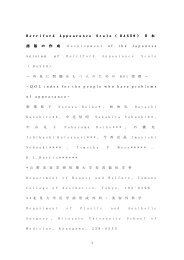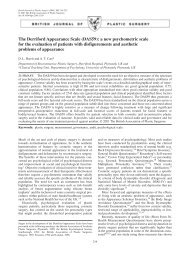DAS-59 - Derriford Appearance Scales
DAS-59 - Derriford Appearance Scales
DAS-59 - Derriford Appearance Scales
Create successful ePaper yourself
Turn your PDF publications into a flip-book with our unique Google optimized e-Paper software.
208<br />
Tony Carr et al.<br />
extremely similar, as are the maxima and minima for the pre-operative clinical and the general populations<br />
(246–10 and 223–8, respectively). These scores reveal a high degree of similarity and overlap between the<br />
clinical and general population samples in terms of the nature and presence of self-consciousness of<br />
appearance. On this basis, and in order to ensure the applicability of factor scores across both populations,<br />
item analyses and principal component analyses were repeated on the combined data set.<br />
The combined data set<br />
Results<br />
Details of the 2741 respondents in the combined data set are given in Tables 1 and 2.<br />
Principal component analysis and subsequent scree test indicated an optimum ve-factor<br />
solution accounting for 63.5% of the variance. A varimax rotation specifying ve factors<br />
identied three main factors (general self-consciousness of appearance (20.05%), social<br />
self-consciousness of appearance (18.47%), and sexual and bodily self-consciousness of<br />
appearance (12.26%)), and two weaker factors (negative self-concept (7.14%) and facial<br />
self-consciousness of appearance (5.61%)). These factors were virtually identical with<br />
those appearing in earlier analyses but were a little more inclusive of scale items. The<br />
factor loadings and item–whole correlations can be seen in Table 3. Of the items, 90%<br />
load at .5 or better and items were assigned to factors according to their strongest<br />
loadings. The few items with appreciable cross-factor loadings (e.g. 29 and 32) were<br />
carefully reviewed in the light of their factor loadings and locations in the earlier separate<br />
sample analyses to ensure consistency of assignment here and a good match with factor<br />
meanings. With a minimum loading criterion of .4, all but two items are included in this<br />
ve-factor solution. Both excluded items (53 and <strong>59</strong>) have adequate item–whole<br />
correlations (.43 and .53) and are clinically descriptive with good face validity for the<br />
clinical population. Also, a slightly more liberal loading criterion of .33 would have<br />
included these items in the factor solution (in Factor 1, General self-consciousness of<br />
appearance). On these grounds it was decided to retain these items but not to assign them<br />
to a factor.<br />
Reliabilities<br />
Full-scale test–retest reliability for the general population was obtained by remailing the<br />
scale to a random sample of 350 original respondents after a period of three months. In<br />
all, 168 replies were received, giving a retest reliability of .75, which is adequate for a<br />
non-clinical population not typically concerned about their appearance. Test–retest<br />
reliability for a clinical sample was obtained from Study 2, in which 2<strong>59</strong> of 365<br />
responders available from the original 606 replied to a three-month retest. This gave a good<br />
test–retest reliability of .86. Internal reliability was calculated on the combined sample,<br />
giving a Cronbach alpha of .98 which conrms the scale’s high level of homogeneity. Test–<br />
retest reliabilities for the factors ranged from .79 (GSC) to .51 (FSC) (SSC 5 .70; SBSC 5 .73;<br />
NSC 5 .70) and Cronbach alphas from .98 to .74 (Table 3).<br />
Validities<br />
Good content validity was achieved by basing the original set of items upon patients’





